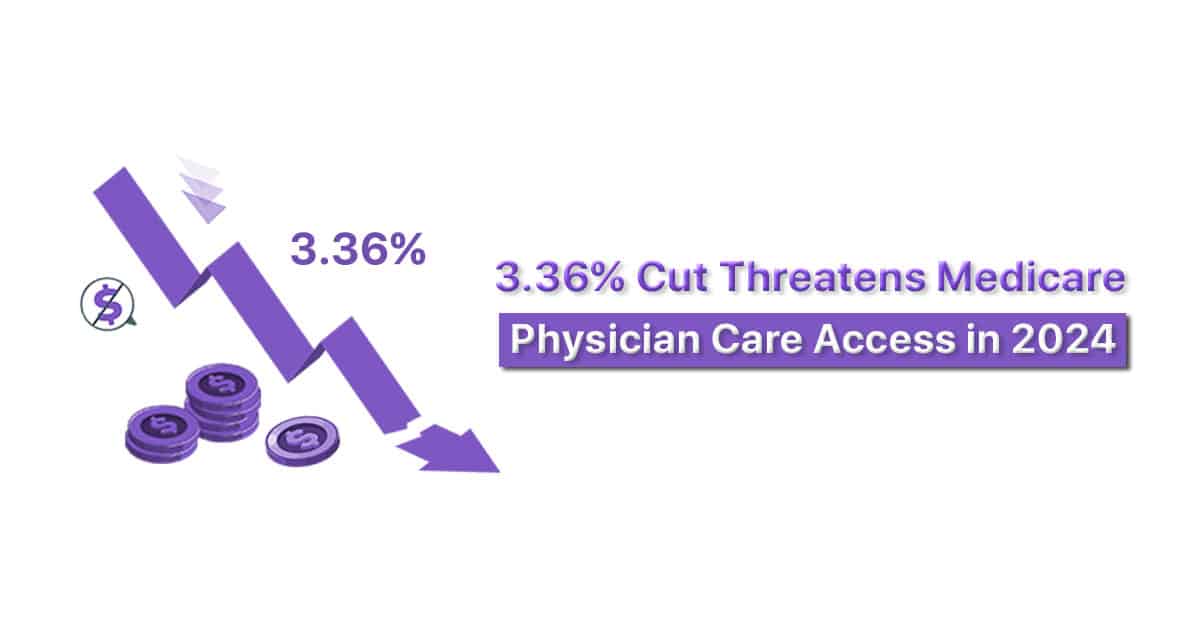What’s the news:
The AMA is emphatically stating that the proposed 3.36% reduction in the 2024 Medicare physician payment schedule is ill-advised, posing a threat to the accessibility of high-quality physician care for the 50 million plus elderly individuals enrolled in Medicare. The AMA President emphasized that with escalating costs associated with medical practice; another year of Medicare payment cuts not only puts patient access in jeopardy but also endangers the viability of physician practices that communities rely upon. These cuts are deemed both unsustainable and morally unacceptable.
In a comprehensive 120-page comment letter (available in PDF format) submitted to the Centers for Medicare & Medicaid Services (CMS) regarding the Medicare physician payment schedule, the AMA pointed out that physicians are confronted with a threefold challenge as impending pay reductions loom on various fronts. The proposed 3.36% decrease can be attributed to two factors. Firstly, a 1.25% reduction arises from a temporary legislative update, and secondly, there is a negative budget-neutrality adjustment associated with the introduction of a CMS-developed office visit add-on code
Why it’s important:
Even prior to the onset of rampant inflation and the epidemic, physicians were grappling with an unsustainable trajectory. When adjusted for inflation, Medicare physician payment has effectively declined by 26% from 2001 to 2023, and this is before factoring in additional inflation and recent cuts. Moreover, in 2023, physicians experienced a 2% reduction in pay. Unlike other providers, physicians lack an automatic increase to offset inflation.
Furthermore, the AMA has received reports indicating that a greater number of physicians and group practices may face penalties under the Medicare Merit-based Incentive Payment System (MIPS) in 2024, based on the recently released feedback for the 2022 performance period. These penalties could lead to reductions in Medicare payment of up to 9%. Notably, MIPS were largely on hold during the 2020 and 2021 performance periods due to the COVID-19 public health emergency. The AMA expresses significant concerns that this could unfairly penalize physician practices, particularly smaller, independent, and rural practices, due to a lack of awareness about the expiration of automatic COVID-19 flexibilities.
Recently, CMS released performance feedback and final scores for MIPS for the 2022 performance year. These scores will determine whether a physician receives a positive, neutral, or negative payment adjustment on Medicare services provided in 2024. Physicians can access this information on the Quality Payment Program website using their HCQIS Access Role and Profile (HARP) credentials. For those who believe there was an error in the calculation of their MIPS final score, CMS offers a targeted review process, with requests to be submitted by Oct. 9.
Furthermore, reductions in physician payment rates will significantly hinder access to care for Medicare patients. The Medicare Trustees have explicitly cautioned that access to physicians for Medicare patients could be seriously compromised in the long term if payment rates do not adjust. Delays in care, particularly among underserved populations with limited access to healthcare, are linked to poorer health outcomes and inequitable healthcare delivery.
AMA President emphasizes, “Policymakers have a responsibility to rectify the Medicare system and prevent these consequences. As physicians, we owe our patients our utmost efforts to ensure that healthcare access is not curtailed. Together with our allies in organized medicine, we are committed to ensuring that both CMS and Congress hear this perspective.”
Momentum is growing for reform. In March, the Medicare Payment Advisory Commission, for the first time, recommended a physician payment update tied to the Medicare Economic Index—the government’s gauge of inflation in medical practice costs. Additionally, in April, a bipartisan group of House members introduced a bill advocating for annual inflation updates to the Medicare pay schedule based on the Medicare Economic Index.
In July, a bipartisan group of 101 House members signed a letter urging urgent action to address challenges in the healthcare system, which has been exacerbated by the pandemic and physician burnout. The letter highlights the problematic Medicare payment system, noting that physician practices are struggling to remain open amidst surging inflation and escalating costs.
The American Medical Association (AMA) has emphasized the urgency of reforming Medicare physician payment as a top advocacy and legislative priority. To provide physician advocates and policymakers with a comprehensive understanding of the intricate landscape surrounding Medicare physician payment reform, the AMA’s Medicare Basics series offers a detailed and accessible overview of crucial components within the payment system, highlighting the need for reform.
In its extensive comment letter, the AMA addressed various areas, including:
• Valuation of specific codes.
• Practice-expense data.
• Evaluation-and-management (E/M) add-on code.
• Appropriate Use Criteria for Advanced Diagnostic Imaging Program.
• Supervision of residents in teaching settings.
• Telehealth and remote monitoring.
• Medicare Shared Savings Program accountable care organizations.
• Diabetes screening.
• Billing for split or shared visits.
For more information on the significance of reforming Medicare payment and to stay updated on other advocacy priorities actively pursued by the AMA, visit AMA Advocacy in Action.

